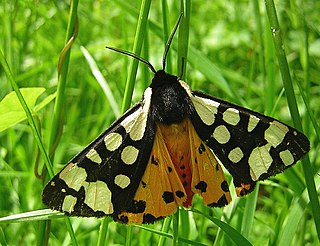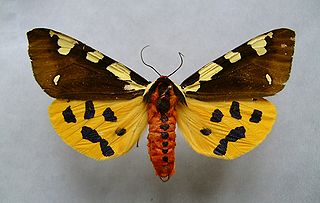
The Arctiina are a subtribe of moths in the family Erebidae.

Arctia is a genus of tiger moths in the family Erebidae. Therein, it belongs to the subtribe Arctiina in the tribe Arctiini in the subfamily Arctiinae. Species are well distributed throughout North America, Palearctic, India, and Sri Lanka.

Arctia villica, the cream-spot tiger, is a moth of the family Erebidae. The species was first described by Carl Linnaeus in his 1758 10th edition of Systema Naturae. It is distributed from the Iberian Peninsula across western and southern Europe, Anatolia, western and northern Iran, western Siberia, southwestern Asia and North Africa.

Arctia is species of tiger moth in the family Erebidae. It was first described by Carl Linnaeus in his 1758 10th edition of Systema Naturae. It can be found in central and eastern Europe, Kazakhstan, southern Siberia, northern Mongolia, Amur Region, Primorye, Sakhalin, Kunashir, northern and northeastern China, Korea and Japan.

Arctia tigrina is a moth of the family Erebidae. It is found on the Iberian Peninsula and the South of France and Italy.

Arctia aulica, the brown tiger moth, is a moth of the family Erebidae. The species was first described by Carl Linnaeus in his 1758 10th edition of Systema Naturae. It is found in the temperate areas of central Europe up to the area surrounding the Amur River to the east and up to the Balkans and the Black Sea to the south.

Arctia dejeani is a species of moth in the family Erebidae first described by Jean Baptiste Godart in 1822. It is found on the Iberian Peninsula.
Arctia churkini is a moth of the family Erebidae. It was described by Saldaitis, Ivinskis and Witt in 2003 and is endemic to Kyrgyzstan.
Arctia cornuta is a moth of the family Erebidae. It was described by Saldaitis, Ivinskis and Witt in 2004. It is found in the Turkestan Mountains at the Uzbekistan-Tajikistan border.
Arctia seitzi is a moth of the family Erebidae. It was described by Andreas Bang-Haas in 1910. It is found in central Asia, including Kazakhstan and Kirghizia.
Arctia dido is a moth of the family Erebidae. It was described by M. Wagner in 1841. It is found in Algeria.

Arctia testudinaria, or Patton's tiger, is a moth of the family Erebidae. It was described by Geoffroy in 1785. It is found from northern Spain to southern and central France and southern Switzerland to north-eastern and southern Italy. It has also been recorded from Great Britain. The habitat consists of grasslands, slopes, forest edges, clear dry forests, cliffs and mountain slopes, maquis, garigues and dry meadows.
Arctia ladakensis is a moth of the family Erebidae. It was described by Otto Bang-Haas in 1927. It is found in Tibet and Xinjiang in China.
Arctia bundeli is a moth of the family Erebidae. It was described by Vladimir Viktorovitch Dubatolov and Vladimir O. Gurko in 2004. It is found in Tadjikistan.
Arctia tancrei is a moth of the family Erebidae. It was described by Staudinger in 1887. It is found in Kazakhstan, Uzbekistan, Tajikistan, Kyrghyzstan and China.
Arctia allardi is a moth in the family Erebidae. It was described by Charles Oberthür in 1911. It is found in China.
Arctia buddenbrocki is a moth in the family Erebidae. It was described by Hans Kotzsch in 1929. It is found in Gansu and southern Shaanxi, both in China.
Arctia cupido is a moth in the family Erebidae. It was described by Yasunori Kishida in 1995. It is found in Nepal.
Arctia hannyngtoni is a moth in the family Erebidae. It was described by George Hampson in 1910. It is found in the north-western Himalayas and Nepal.
Arctia forsteri is a moth in the family Erebidae. It was described by Franz Daniel in 1943. It is found in Sichuan, China.







